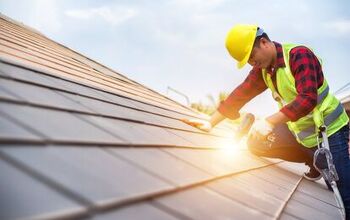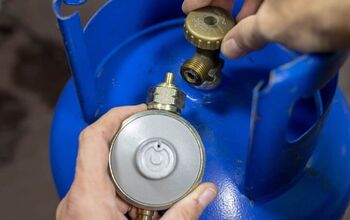Roof Turbine Vents Not Spinning? (Here's What You Can Do)

If you climb into your attics and find your roof turbine vents are not spinning, there may be a moment of panic that sets in. Issues may come up regarding how long this takes to repair, and you may start worrying about the cost. That’s entirely understandable, but with this guide, we will find out how to diagnose any issues and fix them.
Turn off the power if your roof turbine vents are not spinning, and check for any obstructions and remove them. Then, check the condition of the turbine vents and remove any rusted pieces. Also, you will need to replace any pieces of the turbine vents that are not in good condition.
Do You Need Roofing, Siding, or Gutter Installers?
Get free, zero-commitment quotes from pro contractors near you.

How to Fix Turbine Roof Vents That Are Not Spinning
We are going to get into some details behind fixing your roof turbines, or whirlybirds, below. You may not need all the steps, but a full check-up is never a back thing.
Step One: Turn Off The Power To Your Turbines
There is a chance that your turbine may be straining against whatever is stopping it at the moment. To avoid an expensive medical journey, always be sure to turn off the house’s electricity before you begin the process.
It can be done at the breaker switch, as they typically put the turbines under the button labeled “attic.” If you aren’t sure, your turbines may be able to be unplugged.
Step Two: Check And Remove Any Obstructions
Once the power is off, it is safe to start looking at the thing. It is common for attic storage to get a bit out of hand. You may have a small box trapped there. In some cases, you may have insulation as well.
If there is any obstruction, take the opportunity to remove it. You can reactivate the fan after removing it, as this step may be the end of your woes. But anyone who has dealt with DIY issues knows that this is likely not the only problem. It brings us to our next potential point.
Step Three: Check The Condition Of Your Turbines
Over time your roof turbines can age to the point of being non-functional. The age can lead to rusty and old parts, and those parts will need to be potentially replaced depending on the condition of them.
The condition of your turbines will give you an idea of how far you need to make the repairs. In some cases, you may need to replace blades. In most cases, you need to loosen the joints.
In some cases, your turbine vents can also have poor flashing. Flashing is the section of sheet metal located under the shingles.
If it id damaged, rain can leak into the turbine, which can be a significant cause of rest. It is typically due to lazy contractors who are unwilling to fix any mistakes they make.
Step Four: Lubricate The Rusted Pieces
Utilizing WD-40, loosen some of the rusty pieces. Rust is a typical issue behind wind turbines, as they are components of a house that are easy to forget.
Be sure to apply them at any nuts and bolts and any location that needs to move. Just like door hinges, you want to be sure that they are properly lubricated to prevent noise. When lubricating the blade, WD-40 may not cut it. In this case, you can purchase silicone lubricant spray to place in the turbine.
Step Five: Replace Any Pieces That Are Too Far Gone
In the worst-case scenario, roof turbines are either too far gone or rusted to have WD-40 work. It is a more common issue in older houses that have not had much care for them.
In this case, you will need the following supplies:
- Ladder
- Roof cement
- Measuring tape
- Pry bar
- Trowel
- Nails
- Caulk
Measure the old turbine to be sure the new turbine will fit into the gap on the roof. Next, use a pry bar to remove the nails from the top so you can remove the old turbine.
Adjust the new turbine until it meets the angle of the roof. The new turbine comes with clamping screws that will allow you to secure the base. After this, you will apply roof cement beneath the base.
When the turbine and base are correctly aligned, you can use a nail at each corner. Cover the nails with clear caulk and take the opportunity to seal any other pieces. While this is a shortened version, the detailed instructions of installation will come with the owner’s manual of your new turbine.
Pros And Cons Of Turbine Roof Vents
If this situation is causing you to question your turbine roof vents, check out this list of reasons to stick with turbine vents:
- Incredibly useful at venting hot air
- Flexible placement options
- You need fewer turbine vents than you need standard vents
- Require little maintenance
Of course, there are also some cons to owning turbine vents:
- When they stop spinning, they become a standard vent
- Ugly
- A bit unwieldy
- Cost more than standard vents
When compared to other vents, they are a clear winner provided that you are willing to deal with them being on your roof. Some people avoid buying them based on their appearance, as they look like a giant silver mushroom.
Provided you are willing to deal with the appearance. These vents are easily one of the most effective options in ventilation. Just be prepared to shell out a larger amount upfront. However, they are typically more cost-effective than powered roof vents.
Do You Need Roofing, Siding, or Gutter Installers?
Get free, zero-commitment quotes from pro contractors near you.

Related Questions
Should You Cover Turbine Roof Vents In Winter?
Somewhere along the way, you may have heard of the idea that roof vents need to seal during the winter. Do not do this. If heat is unable to escape from the ventilation, it will lead to dangerous situations. You will have a higher likelihood of mold or insects invading your attic.
How Many Roof Turbines Do I Need?
The standard amount of roof turbines per attic square footage is 1 to 300. However, this can depend on the effectiveness of your turbine. Check with the owner’s manual of your turbine to see how many of them you need for installation. If it is not clear, stick with the 1 per 300 rule.
Is It Possible To Have Too Many Roof Vents?
You can have too much exhaust ventilation. A clear sign of this is an incredibly cold attic, as a large amount of heat will escape all at once. If you have more intake ventilation, this is not typically an issue.
Do Roof Turbines Let Rain In The House?
Unless the roof turbine is damaged or poorly installed, it will not allow any rain inside your house. If rain is coming from the whirlybird, you will need to address whoever installed the ventilation. If a contractor did this, they did not perform their work correctly.
Do I Need Powered Roof Ventilation?
Powered ventilation is typically unnecessary. In most cases, it is a significant waste of energy typically solved by modern innovations in ventilation.Whirlybirds are a great example of this, as they are semi-mechanical and rotate using the wind. Powered vents also typically pull the ventilation, causing you to remove things like rain and other unwanted debris through your ventilation. Stick with standard roof ventilation if you can.

I'm a guy who becomes the expert of whatever I stumble upon, writing-wise. I've written tons about cool home products, home improvement, and smart technology in the home. I'm also the proud father of a kiddo born on new years, making my holidays very busy.
More by Eli Smith



























